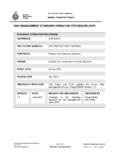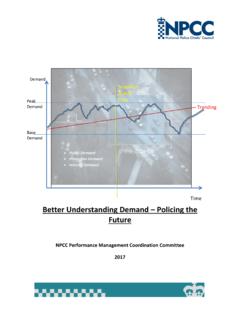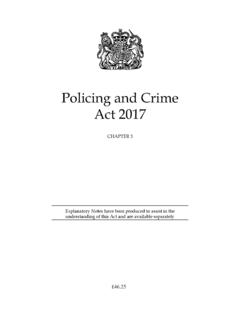Transcription of Striking the balance between operational and health and ...
1 health and Safety Executive1 of 13 pagesStriking the balance between operational and health and safety duties in the Police Service: An explanatory noteForewordIn October 2009 Judith Hackitt, Chair of the health and Safety Executive (HSE), along with Peter Fahy, Chief Constable of Greater Manchester, and Sir Hugh Orde, President of the Association of Chief Police Officers (ACPO), launched the statement: Striking the balance between operational and health and safety duties in the Police Service ( ).The statement is one of high-level principles intended to clarify how health and safety law will be applied to operational policing. It recognises the particularly challenging nature of operational policing and the dangerous environments in which officers and staff have to work.
2 It sets out what HSE expects of the police and what the police can expect of HSE. The statement makes it clear that health and safety law does not prevent the police from delivering an effective emergency service. This note supports the statement by providing an explanation of its principles. HSE will work with others producing operational policies and guidance to ensure that they incorporate the principles of the statement and that health and safety considerations are fully integrated into operational policies and guidance. HSE would like to thank the following organisations for their help in developing and endorsing the Striking the balance statement and in helping to integrate its principles into police operations.
3 Association of Chief Police Officers Association of Chief Police Officers Scotland Police Federation of England and Wales Scottish Police Federation Police Federation of Northern Ireland Superintendents Association of England and Wales Association of Scottish Police Superintendents Superintendents Association of Northern Ireland Association of Police health and Safety Advisers Association of Police Authorities National Policing Improvement Agency The Home Office The health and Safety Executive for Northern Ireland 2 of 13 pagesHealth and Safety ExecutiveStriking the balance between operational and health and safety duties in the Police Service: An explanatory noteIntroduction 1 This explanatory note supports the high-level statement Striking the balance between operational and health and safety duties in the Police Service.
4 It fully implements the recommendation of Common Sense, Common Safety, October 2010: Police officers should not be at risk of investigation or prosecution under health and safety legislation when engaged in the course of their duties if they have to put themselves at risk as a result of committing a heroic act . It also provides:clarification of the terminology used in the statement; case studies illustrating how effective and efficient policing can be delivered without compromising the health and safety of police officers, staff and the public;an example of HSE enforcement action. 2 This guidance is primarily intended for police services and HSE HSE fully recognises that, as part of their normal work, police officers and some other police staff inevitably face significant and serious dangers and sometimes unrealistic public expectations.
5 The nature of policing is such that it is not always possible to completely control all risks. It is precisely because the police are expected to face significant dangers as part of their job that health and safety management in the Police Service needs to be integrated with operational management arrangements. Controlling health and safety risks requires consideration of what might happen in advance, so that sensible and speedy responses can be initiated that will not impede the job to be done. Effective and efficient management of health and safety to protect the police goes hand in hand with delivering an effective and efficient policing service. 4 The special nature of operational policing may require that certain risks are taken to secure appropriate benefits to the public and the wider society, such as saving life, preventing serious crime and apprehending those responsible for serious crime.
6 However, there is still a requirement for those risks to be minimised as far as reasonably practicable in the context of operational policing (see paragraphs 11 18). 3 of 13 pagesHealth and Safety ExecutiveStriking the balance between operational and health and safety duties in the Police Service: An explanatory noteCase study: The need to take certain risks in order to carry out specific policing activitiesScenarioArmed gunmen in an enclosed building on a main street were holding a large number of members of the public hostage. The aim of the police operation was to safely rescue the hostages and arrest the hostage takers. Negotiation was unsuccessful and there was a stand-off between the hostage takers and the police.
7 In view of the deadlock, the police decided to enter the building to rescue the the building could have resulted in serious injury or death to hostages, police officers and hostage takers. The situation was very unpredictable; the hostage takers were frustrated, angry and tired as the situation had been going on for some time. The hostages were likely to act in an unpredictable manner because they were scared and tired. The information available to the police about the hostage takers, their physical and mental state and that of the hostages was limited and continually changing. Risk-benefitIn the light of the available information, ie the stalemate with negotiations and perceived immediate risk to life, the senior officer in command of the situation decided to carry out a rescue using specially trained officers to enter the building, using force if necessary.
8 The senior officer in command was aware of the high risk but she believed that it was necessary to take this action despite the risks involved on the basis that, on balance , it was more likely to prevent death or serious injury arising from unlawful violence than would otherwise be the case. The surrounding community was also at risk from the unpredictable events that could arise, eg fire, explosion and gunshots, as well as the disruption to their lives. It was a policing imperative to resolve the situation, despite the risks to life. Reasonably practicable actionsAlthough it was an unpredictable situation, the following reasonably practicable actions were implemented to minimise the safety risks of the operation: the surrounding area was cleared and roadblocks were set up; specially trained and fully briefed officers were brought in to carry out the rescue; communication within the chain of command was put in place and operational - specific terminology was used so that everyone could understand the instructions;other emergency services were co-ordinated.
9 ResultThe specially trained officers entered the building. Confusion and panic developed and, in the ensuing confrontation, the hostage takers opened fire on the police. Several hostages and a police officer were injured. The police officer later died in hospital from their injuries. Key pointsSerious risks were taken to carry out the rescue, but this was a policing imperative and the benefit of resolving the situation outweighed those were implemented to minimise the risks as far as reasonably practicable, and the relevant standard operating procedures were implemented to deal with known risks. The incident commander made a sound risk-benefit decision based on the information, intelligence and resulting threat assessment available to her at the of 13 pagesHealth and Safety ExecutiveStriking the balance between operational and health and safety duties in the Police Service: An explanatory noteApplication of health and safety legislation to the Police Service5 In Britain, the Police ( health and Safety) Act 1997 made police officers employees for the purposes of health and safety legislation.
10 The health and Safety at Work etc Act 1974 (HSWA) and the regulations made under it apply to all work activities. A breach of any of these duties is a criminal act. The Act imposes duties on employers and employees and is based on the philosophy that those who create the risks should manage them. There are specific regulations made under HSWA, for example the Management of health and Safety at Work Regulations and the Control of Substances Hazardous to health Regulations. Further information can be found on HSE s website ( ).6 Under HSWA, employers should:ensure, so far as is reasonably practicable, the health , safety and welfare at work of all their employees; andconduct their undertakings in such a way as to ensure, so far as is reasonably practicable, that persons not in their employ who may be affected are not thereby exposed to risks to their health and safety; and employees should:take reasonable care of their own health and safety and of others who may be affected by their acts or omissions at work; andco-operate by following any requirement imposed on them by their employer, for example to follow safe systems of work and to use personal protective is the employer in the Police Service?















